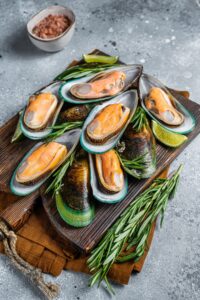Though they may look alike, leeks and green onions are different. Leeks are larger and thicker than green onions, and their taste is milder.
Still, at a glance, the two are remarkably similar. They both feature a thick, white base. And they both have shoots of long, thin, rectangular-shaped green leaves.

Their similarities stem from the fact that they both come from the same genus.
Let’s take a deep dive into the leeks vs. green onions debate and settle it once and for all.
What Are Leeks?
(scientific name: Allium ampeloprasum)
Leeks are edible green veggies with white stalks. They’re closely related to onions, shallots, chives, and ramps.
Like green onions, they have a thicker white base and long green leaves. Their leaves start out light green but become darker at their tops.
The white base, or stem, is generally between 6 to 12 inches long. The leaves are almost double that size and can grow up to 3 feet tall!
Most people cook with the white and light green parts only. The dark green parts are tough and fibrous. They’re great for adding flavor to soups and stews, though.
They taste like subtler, milder onions.

What Are Green Onions?
(scientific name: Allium cepa)
Green onions are young onions with edible white bulbs and edible green leaves. Some people call them scallions instead. They look like smaller, thinner leeks.
Their taste is more pungent than leeks. However, they’re milder and less sharp than full-grown yellow, white, or red onions. The leaves are even fresher and milder than the bulbs.
Leeks vs. Green Onions: What’s the Difference?
As mentioned, green onions and leeks are different plants. However, their differences primarily boil down to four main factors:
- Species. They come from the Allium genus but aren’t the same species. Green onions are Allium cepa, while leeks are Allium ampeloprasum.
- Appearance. Both plants have thicker white bulbs and thinner green leaves. However, green onions are noticeably smaller than leeks. They don’t grow as large lengthwise, and the bulbs and leaves are thinner than leeks.
- Taste. Green onions are earthier, sharper, and more intense than leeks. (They’re still the mildest onion variety, though.)
- Cooking times. Because leeks are larger and more fibrous, they take longer to cook than green onions. This makes them perfect for adding to long-cooking dishes like soups and stews. Green onions cook quickly and do best in stir-fries or when added raw to recipes.

How to Use Leeks
You can cook leeks in many ways, including:
- Braising
- Caramelizing
- Poaching
- Grilling
- Roasting
- Frying
- Etc.
You can also eat them raw or use them as a garnish.
They’re perfect for adding to soups, stews, and other slow-cooking recipes. You can even work them into fillings for dumplings or pierogies.
How to Use Green Onions
You can also enjoy green onions raw or cooked. However, their small size and tenderness make the leaves unsuitable for lengthy cooking.
Therefore, people most commonly enjoy the leaves raw. Here are some of the most popular ways to enjoy raw green onions:
- By themselves as a snack
- In salads
- As a garnish or topping for meats, rice dishes, soups, chili, etc.
- Diced and added to melted butter
As for cooking them, here are a few ideas:
- Add them to biscuit, pancake, or fritter batter.
- Use them in stir-fries.
The white bulbs hold up better under heat. You can cook them in many of the same ways you can cook leeks or other onions. Sauteing is one of the most popular cooking methods.

Can You Substitute Leeks for Green Onions?
You can substitute leeks for green onions in most recipes and vice versa. However, there are a few things to keep in mind.
- Green onions are stronger than leeks. So, using them in place of leeks will give your dish a stronger taste. Using leeks instead of green onions will make your dish taste milder.
- Leeks are larger and more fibrous than green onions. Therefore, you need to slice them into very thin strips. You also need to cook them longer to overcome their toughness.
- Green onions are smaller than leeks. Purchase more green onions for a recipe to get the same amount of leeks. (i.e., One leek stalk may require two or three bunches of green onions.)
Still, in most recipes, swapping one ingredient for the other works just fine.










